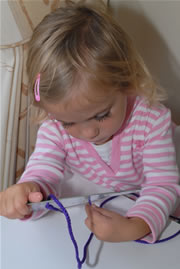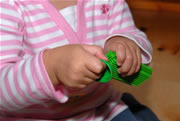Developing Motor Skills - how to help your child with play and hand skills at around the 2 to 3 year level
 The information on this page is also available to download:
The information on this page is also available to download:
At this age children will be developing more sophisticated play with early construction, beginning to use two hands together with more control and starting to pick a favourite hand for activities like feeding or scribbling. They will be showing more interest in pretend play, and will enjoy playing alongside other children.
Children begin to enjoy a wider variety of messy play with sand, water, paints, gloop and gluing to develop interest in touching and using different textures as well as developing skills in drawing and constructing.
Children need to experience toys and activities that encourage both hands to develop good manipulative skills and also require both hands to work together.
Threading toys like cotton reels, big button or beads. Using thick  cords or stiffened laces might help to start or even pipe cleaners or straws. Other toys that need to be held in one hand and operated by the other hand like wind up toys, toys with a pull string will help develop two hand skills and help the child to decide on a favourite hand.
cords or stiffened laces might help to start or even pipe cleaners or straws. Other toys that need to be held in one hand and operated by the other hand like wind up toys, toys with a pull string will help develop two hand skills and help the child to decide on a favourite hand.
A favourite hand may be seen when feeding or scribbling and it will be the hand used to operate the more difficult features of a toy. Some children are much later at developing a favourite hand and having lots of these type of play experiences will help.
At this stage you should not be concerned if your child does not appear to be developing a favourite hand.
Scribbling and construction will become more controlled. Circular scribbles and dots will develop first and then straight lines will be part of their drawings before anything recognisable is seen. ‘Drawing’ can be done with water on a brush on a surface, a stick in sand, finger paints and chalks as well as crayons and pens. Simple tearing and cutting activities with safe children’s scissors to make pictures and collages will be enjoyable. Children enjoy gluing and painting with bits and bobs of household materials to make junk models. It is important to talk to your child about their drawings, paintings and models, to encourage them by joining in and admiring their attempts but not directing them too much.
 Simple construction toys like building blocks, duplo, and big meccanno help to develop manipulation and children will start to tell you what they are building even if it is not always recognisable. Again it is important to admire and praise your child’s attempts.
Simple construction toys like building blocks, duplo, and big meccanno help to develop manipulation and children will start to tell you what they are building even if it is not always recognisable. Again it is important to admire and praise your child’s attempts.
More complicated peg puzzles, shape posting boxes and simple jigsaws will help to improve hand control and develop understanding of shape. Colour matching games, toys and books will be of interest to your child as they begin to match red, blue, green and yellow and perhaps name one or two of them.
Children begin to enjoy simple stories, picture books and nursery rhymes. Encourage pointing to and finding things on the page and talking about the pictures and stories. Nursery rhymes with finger actions are good to develop hand skills.
As children develop better language skills pretend play starts to develop with dolls, dolls houses, toy telephones, cars and garages, trains. Pretend play with old kitchen jugs, pans etc, empty cereal boxes and washed out yoghurt pots will begin as well as copying domestic activities like washing up and dusting.
They might be interested in other children and want to play alongside them but might not yet be able to share or play together. They will enjoy singing games, nursery rhymes, music making and play, but will often look to an adult for support. Crèche, two’s groups and playgroups will provide a good setting for this social play.

